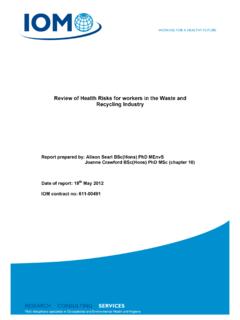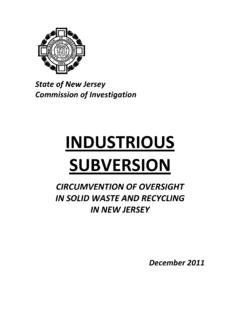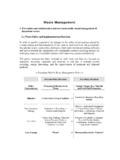Transcription of worker fatalities in the waste and recycling industry
1 Common human factors underlying worker fatalities in the waste and recycling industry Prepared by the Health and Safety Executive RR1128. Research Report Crown copyright 2018. Prepared 2017. First published 2018. You may reuse this information (not including logos) free of charge in any format or medium, under the terms of the Open Government Licence. To view the licence visit , write to the Information Policy Team, The National Archives, Kew, London TW9 4DU, or email Some images and illustrations may not be owned by the Crown so cannot be reproduced without permission of the copyright owner. Enquiries should be sent to Improvement in health and safety performance in the waste sector is a priority for HSE.
2 The waste management and recycling industry accounts for about of employees in Great Britain. However, the fatal injury rate was fifteen times greater than the average across all industries over the period 2012/13 2016/17. This report describes research to identify common underlying human factors that have contributed to fatal incidents within the waste and recycling industry . Eighteen fatal incidents were analysed: 12 in small and medium enterprises (with less than 250 employees) SMEs, and 6 in large enterprises. The research identified four top level human factors: (i) preconditions for deficit' (ie fundamental issues) such as lack of separation of workers and hazardous machinery; (ii) organisational influences' such as inadequate safety management systems and safety culture.
3 (iii) individual actions' such as tasks not being performed in the safest manner; and (iv) wider influences' specific to SMEs such as machinery that is supplied to them with inadequate documentation on safe operation. The majority of factors were not specific to company size. The research also identified potential actions to reduce the likelihood of future fatalities . These focus on: equipment selection, use and maintenance; raising awareness of associated risks; the need for effective safety management systems; and the sharing of good practice. These potential actions are irrespective of organisational size. This report and the work it describes were co-funded by the Health and Safety Executive (HSE) and CIWM, the professional body for resource and waste management.
4 Its contents, including any opinions and/or conclusions expressed, are those of the authors alone and do not necessarily reflect HSE policy. 2. Common Lorem human ipsumfactors dolor underlying sit amet worker fatalities inadipiscing consectetuer the waste and elit recycling industry Philip Beards, Malcolm Cope and Sarah Longden Health and Safety Executive Harpur Hill Buxton Derbyshire SK17 9JN. 3. Acknowledgements We would like to thank the CIWM, the professional body for resource and waste management, for their financial contribution to this project and the Health and Safety Executive inspectors interviewed during this research for their time and contributions. 4. KEY MESSAGES.
5 The GB waste and recycling industry has a high rate of worker fatalities . This rate was fifteen times the average rate across all industries for the period 2012/13 2016/17. Human factors issues within the industry are a contributory cause. Research was carried out to identify common human factors underlying fatal incidents and to provide insights into possible options for concerted action to help reduce the likelihood of serious incidents or fatalities . The research reviewed 18 fatal incidents and included in-depth interviews with HSE inspectors involved in the incident investigations. Of these incidents, 12 were in small and medium enterprises', SMEs (with less than 250 employees) and 6 in large enterprises (250 or more).
6 The research identified four interrelated key human factors issues: 1. Fundamental issues - Preconditions for a deficit'. These issues relate to: the work environment, specifically the lack of separation between people and the hazardous machinery on sites; equipment that does not appear to be fit for purpose; the equipment's design and/or lack of maintenance; and poor practice in how machines are used. This is broadly consistent for SMEs and large enterprises. However SMEs appear to have more of an issue with maintenance. 2. Organisational influences. Generally, safety management systems were found to be inadequate and there were suggestions of poor safety culture in two thirds of cases.
7 This is broadly consistent for SMEs and large enterprises. However, SME's appear to have more of an issue identifying control measures and there is some indication SMEs may have a worse safety culture. 3. Individual action Performance Deficit'. Knowledge based errors appear to be the most significant as a result of individuals not having the necessary knowledge to perform or plan a task in the safest manner. There are examples of deliberate actions on site routine or situational but there are other influencing factors potentially affecting their occurrence. There are also issues as the result of failures of machinery and/or materials. Issues related to knowledge based errors and deliberate actions were broadly consistent for SMEs and large enterprises.
8 However there are slightly more occurrences of failures of machinery and/or materials in SMEs. 4. Wider influences were identified that related solely to SMEs. Some machinery was supplied with inadequate documentation, which meant the purchaser did not understand how to operate it correctly. In a small number of fatal incidents, external consultants provided inadequate risk assessments making an incident more likely to happen because inadequate controls were put in place. The research identified two priority human factors areas to tackle to reduce worker fatalities : equipment factors including design, use and maintenance; and safety management systems. For example, whilst it is foreseeable that some organisations (both SMEs and large) may think their SMS.
9 Is adequate and well documented the analysis indicated this was not always the case. The research also identified potential options for solutions to tackle these human factors issues. These options are intended to act as discussion points between the regulator and industry to inform decisions on what will work in practice and what can be adapted to work within industry . The options focus on: equipment selection, use and maintenance in the industry ; and raising awareness of the risks associated with equipment and the legal requirements for equipment use and maintenance. Related to this is the need for effective safety management systems and the sharing of good practice. 5. EXECUTIVE SUMMARY.
10 Background The waste management and recycling industry accounts for about of the employees in Great Britain. However, the fatal injury rate for workers is over three times greater than in the construction industry (6% of employees) and fifteen times greater than the average rate across all industries over the five year period 2012/13 2016/17. An improvement in overall health and safety performance in the expanding waste and recycling industry is a priority for HSE. Collaboratively, HSE. and industry stakeholders have developed a strategy with an aim of achieving zero deaths in the industry . Aim The aim of the research described in this report was to: identify common underlying human factors that have contributed to worker fatalities within the waste and recycling industry ; and provide insights into possible options for concerted action to help reduce the likelihood of serious incidents or fatalities .















